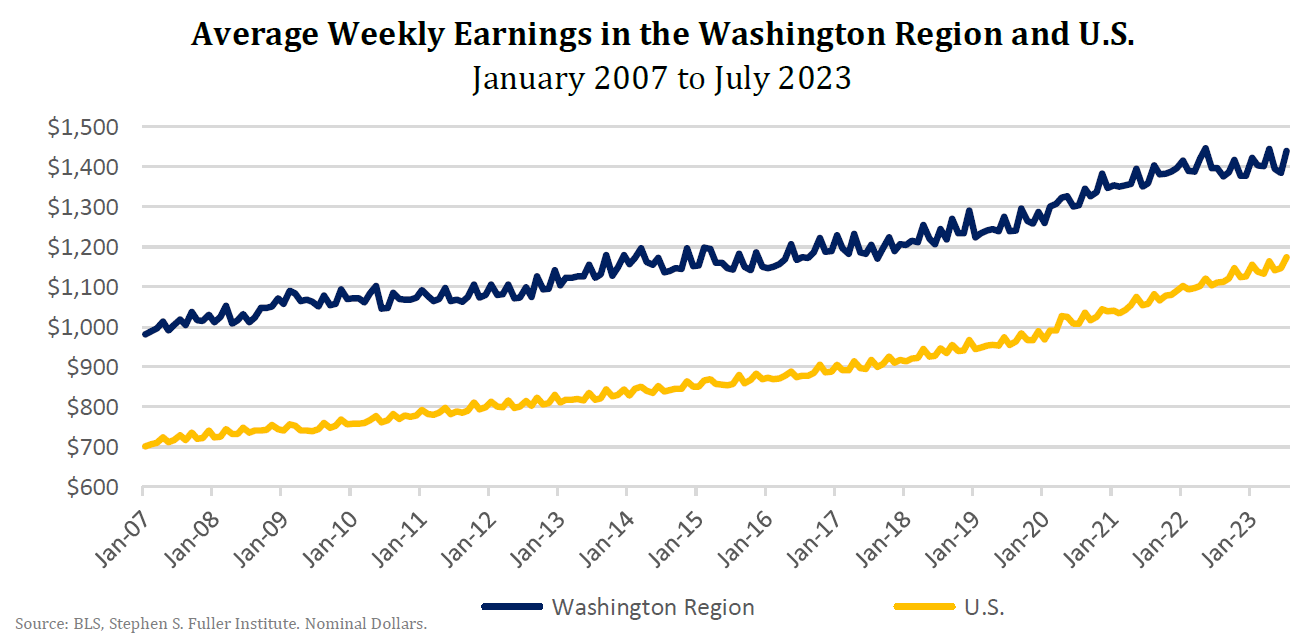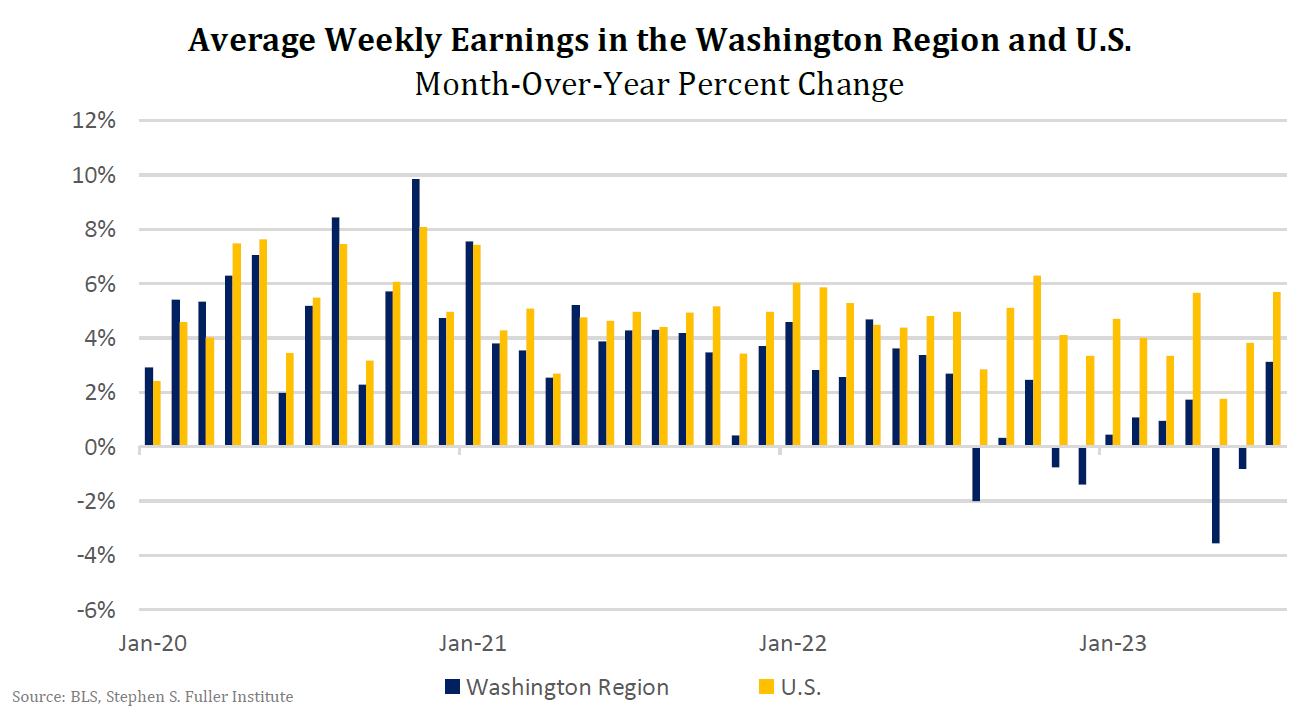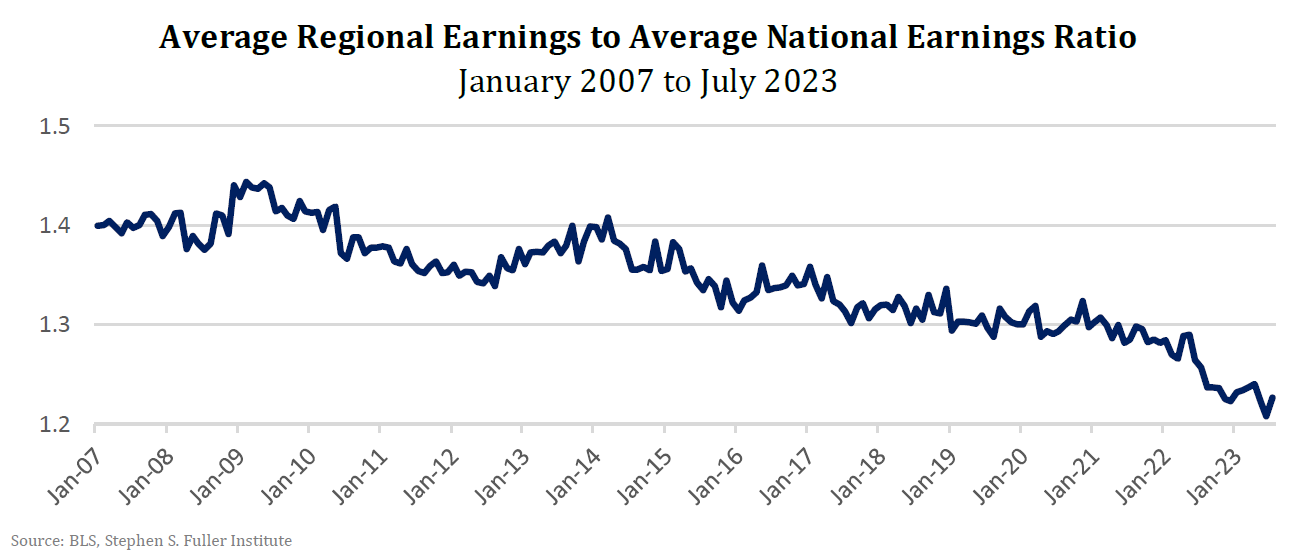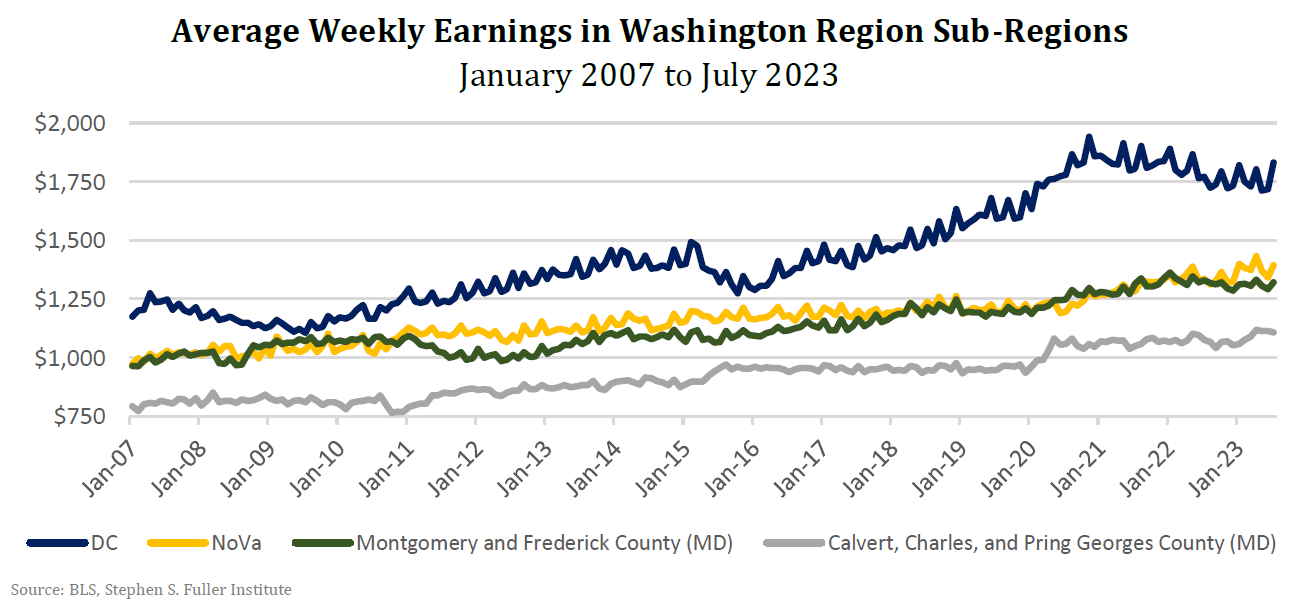REGIONAL ECONOMIC NOTE No. 23-10
Keith Waters and Terry Clower
Download Full Economic Note as a PDF >>
While the Federal Reserve has increased interest rates at a historically fast pace, the U.S. economy has continued to grow at faster than anticipated rates, keeping inflation a concern. One aspect of the nation’s economy that has been surprisingly resilient is the labor market. Nationally, job growth has continued unabated, with workers receiving wage increases as a result of labor demand outstripping labor supply. This regional economic note examines the average weekly earnings of all workers in the Washington region. Regional weekly earnings are compared to national weekly earnings before being decomposed to examine sub-regional weekly earnings growth.
The Washington region has recorded higher weekly earnings than the nation for over 16 years. Average weekly earnings in the Washington region (average regional earnings) increased from $981 in January 2007 to $1,1420 in April 2022. Average weekly earnings in the U.S. (average national earnings) increased from $701 to $1,102 over the same period. Following this period of earnings growth regionally and nationally, average regional earnings stagnated while average national earnings continued to increase. Average regional earnings increased 1.4% from April 2022 through July 2023, while average national earnings increased 6.5% over the same period.

The slowdown in regional earnings growth in the summer of 2022 is more evident when examining month-over-year average earnings changes. Both average regional earnings and average national earnings recorded month-over-year increases of approximately 4.5% to 5% from January 2020 through April 2022. Over the next few months, however, month-over-year increases in average regional earnings slowed rapidly before turning negative all while average national earnings continued to record steady increases. Average regional earnings decreased month-over-year for 5 of the 12 months from August 2022 to July 2023, despite continued growth nationally.

Examining the average regional earnings to average national earnings ratio reveals that the average regional earnings premium in the Washington region has lost ground to the average national earnings. In January 2007, average regional earnings were 1.40 times greater than average national earnings. Setting aside the increase from 2012 through spring 2014, the regional-national wage ratio began declining steadily in March 2014. In May 2022, average regional earnings were only 1.28 times greater than average national earnings. Following the recent decline of average regional earnings coupled with national increases, average regional wages sank to just 1.22 times greater than average national earnings by December 2022, remaining essentially flat through July 2023. While weekly earnings in the Washington region have continued to increase, regional increases have lagged behind national increases for nearly a decade.

The weakness in earnings growth in the Washington region over the past several years can be traced to wage trends in the District and the sub-region that includes Montgomery County, MD and Frederick County, MD. Despite having substantially higher average weekly earnings than other sub-regions, average DC earnings peaked at $1,941 in November 2020, trending negative thereafter. While average Montgomery-Frederick earnings peaked in January 2022, average earnings in the sub-region stagnated through October 2022 before trending downwards. In contrast, average earnings in the sub-region that includes the Maryland counties of Calvert, Charles, and Prince George’s trended positive over the same period, albeit slowly. Average weekly wages in Northern Virginia have outperformed the other sub-regions, with average weekly earnings steadily increasing consistently for the past 16 years, including the post-pandemic era.

Conclusion
While the Washington region has long had greater average weekly earnings than the U.S. as a whole, average regional earnings began to slow in 2022 while average national earnings continued to rise. Despite the fact that average regional earnings increased 4.7% from April 2021 to April 2022, compared with a 4.5% increase nationally, average regional earnings growth decelerated rapidly throughout 2022. The Washington region recorded a month-over-year decrease of 2.0% in August 2022 while the U.S. recorded an increase of 2.9%. The recent slowdown has accentuated a long-developing trend of average national earnings growing faster than average regional earnings. However, the weakness in average regional wages results from earning declines in the District since January 2022 and declines in the Montgomery-Frederick sub-region since July 2022.
Developments in average weekly earnings are likely to result in three key impacts on the region’s economy. First, this is likely to result in continuing migration out of DC and the Montgomery-Frederick sub-region, particularly of domestic migrants, as relative economic opportunities elsewhere become more attractive. Second, Northern Virginia appears poised to capture an even greater share of the region’s labor force. As written previously (here), Northern Virginia now accounts for roughly half of the region’s labor force. Moving forward, Northern Virginia’s share of the labor force appears likely to increase further as the average weekly earnings continue to increase, as those in other sub-regions stall or decline. Finally, the change in earnings will impact tax collections and housing prices, positively in Northern Virginia and negatively in DC and suburban Maryland.
About These Data All data used in this regional economic note come from the U.S. Bureau of Labor Statistics (BLS). The program that produces these data is the Current Employment Statistics, which produces both the national as well as regional estimates. The BLS surveys roughly 131,000 business and government agencies. The data include average weekly earnings of all employees, in dollars. Dollar values are not inflation adjusted. Earnings are total private sector earnings, and thus exclude government earnings. Data are not seasonally adjusted. Average weekly earnings are produced using average hourly earnings and average weekly hours. Average hourly earnings exclude benefits, bonuses, taxes, etc.
